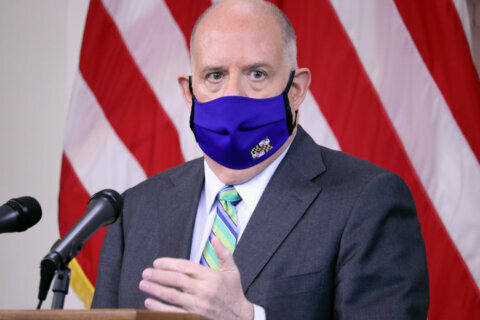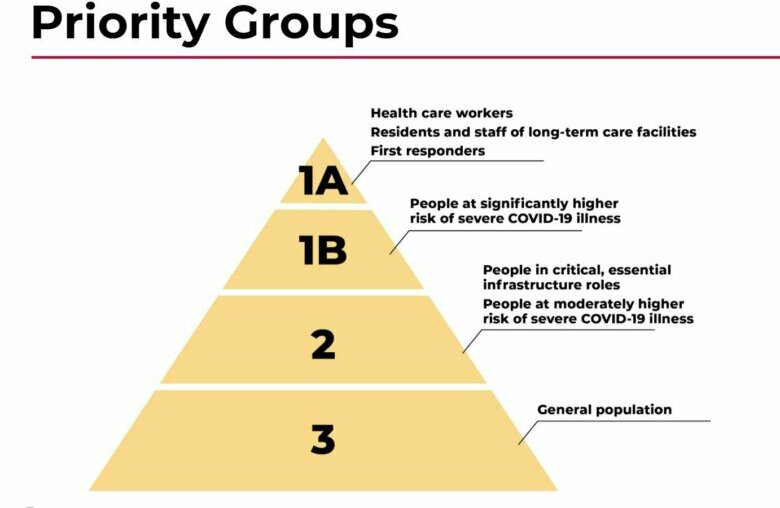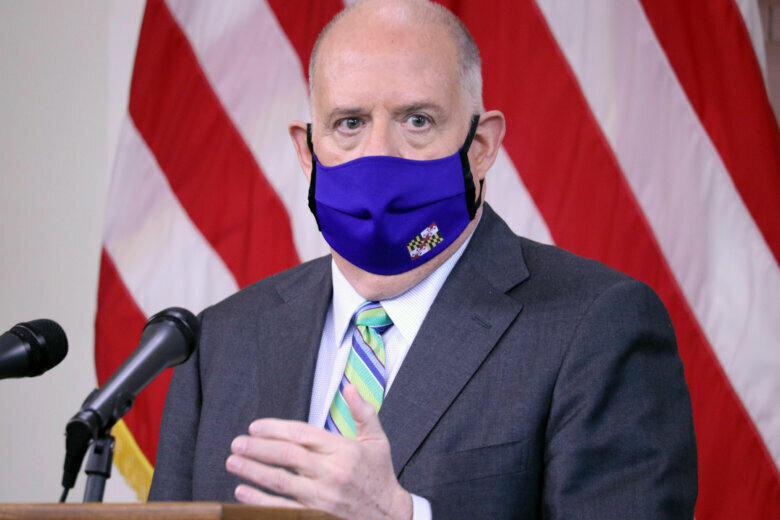
Gov. Larry Hogan offered a welcome reminder Tuesday to Marylanders.
“The cavalry is coming,” Hogan said during an afternoon briefing on the state’s COVID-19 pandemic response. “A vaccine is on the way.”
The monthslong wait continues though, and hours after U.S. regulators confirmed Pfizer’s promising claims about its coronavirus vaccine, Hogan and Maryland health officials gave a rundown of how the state plans to hit the ground running with its initial distribution.
Vaccine priorities: How DC, Md., Va. will handle distribution
The first 155,000 doses allocated to the state will include 50,700 doses of that Pfizer vaccine. They expect distribution to begin next week.
Distribution of the remaining 104,300 doses, which will be of Moderna’s, is expected to begin the following week.
Each person will need two doses of a vaccine to be fully immunized. And, according to Bryan Mroz, the state health department’s assistant secretary and chief medical officer, those initial 155,000 will be first doses.
The federal government, Hogan said, is holding back on that second batch, but he’s been assured that the state will have 300,000 by month’s end.
Health care workers, as well as staffers and residents of long-term care facilities, will get top priority.

Additional doses will be distributed weekly, and state health officials have taken measures to ensure any health care professional can administer vaccinations with proper training.
Maryland has acquired the ultracold freezers needed to keep the Pfizer vaccine at -80 degrees Celsius. (Pfizer has also developed special containers that will keep doses preserved with dry ice.) Moderna’s vaccine, however, only needs to be stored at about -20 Celsius.
The state will track vaccinations online at md.myir.net, and will launch a campaign aimed at boosting public confidence in the vaccine. To that point, Hogan said both he and Lt. Gov. Boyd Rutherford will get their shots in public to prove its safe.
A hyperlocal, “targeted outreach” will use trusted community figures to assure residents, and the state will actively address any rumors and misinformation about COVID-19 vaccines on social media.
“We’ve got to convince folks to do it, or we’re not going to be able to stop the spread,” Hogan said.
Any side effects are mild and similar to those of a flu shot, said Dr. Jinlene Chan, the state health department’s acting deputy secretary of public health services. Those include pain at the injection site, mild fever, headache and joint aches.
The latest good news on a vaccine comes amid a decidedly mixed picture around the state.
Maryland is outperforming most other U.S. states in terms of test positivity rate (eighth-best nationally) and case rate (ninth-best nationally), among other key metrics.
But the state has had over 35 days straight of at least 1,000 new cases. And, at last count, 1,653 were being hospitalized with COVID-19 — the most since May.
Experts predict this will worsen in the near future, a dire outlook that Hogan shared.
“We still don’t believe we’re at the peak,” the governor said. “We think that’s coming in the weeks and potentially months ahead.”
As of Tuesday afternoon, over 4,700 Marylanders have died from COVID-19.
- Sign up for WTOP alerts
- Latest coronavirus test results in DC, Maryland and Virginia
- US virus deaths hit record levels with the holidays ahead
- Why DC isn’t issuing a stay-at-home order yet
- Coronavirus vaccine FAQ: What you need to know
- Grim outlook for Maryland restaurant business in survey
- Montgomery Co. works to promote confidence in COVID-19 vaccine
Looking for more information? D.C., Maryland and Virginia are each releasing more data every day. Visit their official sites here: Virginia | Maryland | D.C.
Montgomery Co. officials say full rollout will take months in ‘best-case scenario’
Earlier in the day, Montgomery County officials discussed local planning for the distribution of the coronavirus vaccine, saying it will likely be months before the vaccine is offered to everyone in the county.
Dr. Travis Gayles, the county’s health officer, said even with approval of the Pfizer vaccine this week by the Food and Drug Administration, getting vaccines to the public will happen in a series of steps.
The earliest phase of vaccination could roll out as early as mid-December, said Gayles, but the general public would not be part of that first wave.
In the first phase, health care workers and residents of nursing homes — including assisted living facilities — would be vaccinated. It would be months before all four phases of distribution are expected, said Gayles.
“Realistically, we’re looking at a four-to-six-month process — best-case scenario,” he said.
Several Montgomery County Council members noted that the county’s efforts to get the public to respond to the U.S. Census had been very successful, and urged the county to use that as a model to get residents to participate in the county’s vaccination outreach. This year, the county’s response rate was 78% — higher even than the rate in 2010.
“They were just rock stars in what they were able to accomplish,” said Council member Nancy Navarro, referring to the county’s Office of Community Partnerships and Census Management staff.
Health and Human Services Director Raymond Crowell told the council he’d be working alongside Gayles and Dr. Earl Stoddard, the director of the Office of Emergency Management and Homeland Security, to encourage residents who are skeptical of the safety of vaccines and of the medical community in general.
“We’ve got a tremendous lift ahead of us between now and the time the vaccine is generally available to the public,” Crowell said, to knock down what he called “myths” surrounding vaccines.
Discussion of the vaccination efforts in Montgomery County came the same day the case rate per 100,000 residents hit its highest level in the county — 41.5. Just a month ago, the case rate was 16.7.
Overall, the county recorded 402 new cases Tuesday morning, and the test positivity rate stood at 6%, compared to 7.6% statewide.
Gayles said he was aware of criticism that the county’s health department had been “creating panic intentionally” by releasing statistics on the virus. But he said that wasn’t the department’s aim.
“We’re simply reporting the numbers where they are, and the numbers speak for themselves,” Gayles said.
WTOP’s Kate Ryan contributed to this report.









